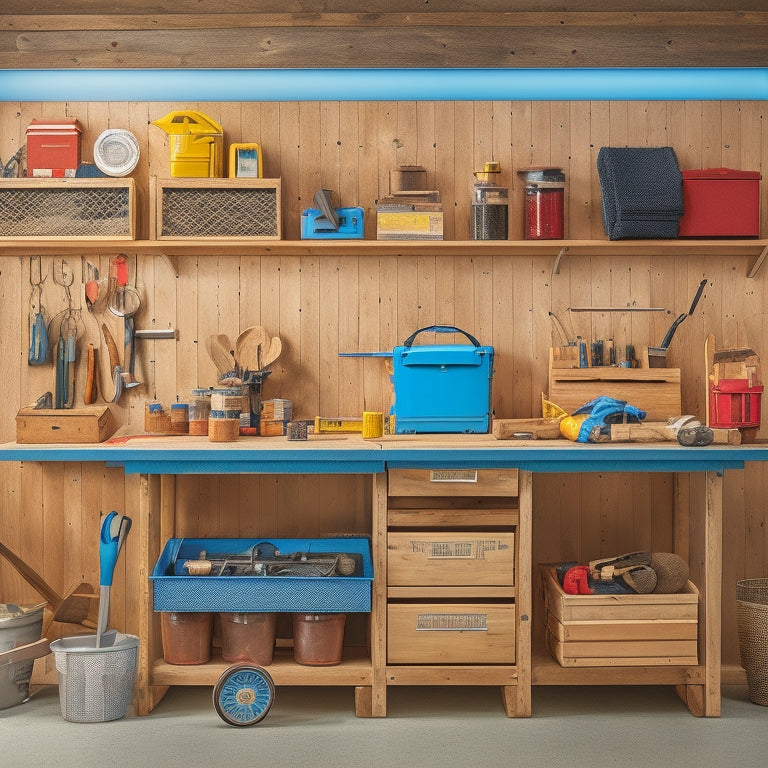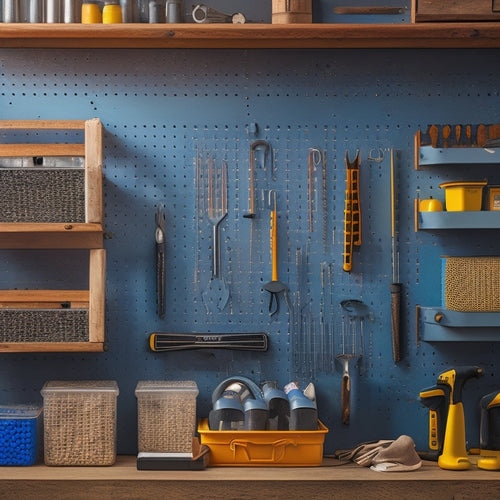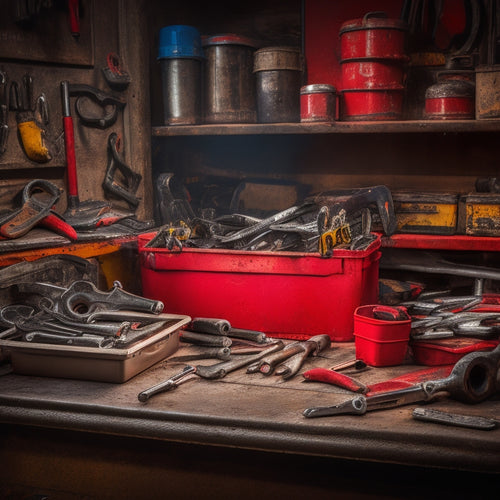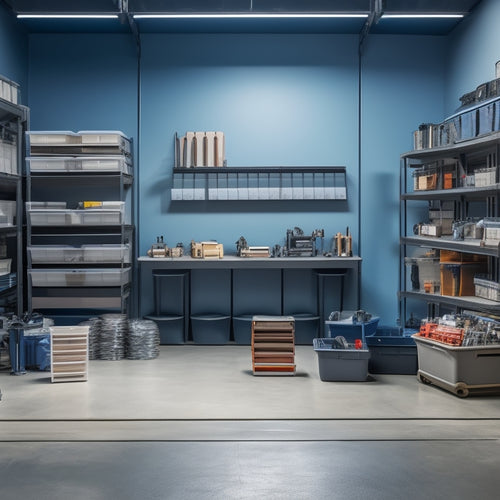
10 Best DIY Tool Storage Projects for Beginners
Share
You're just a few DIY projects away from a clutter-free workspace! To get started, try repurposing a pallet into a tool holder, creating a customizable pegboard for your garage, or organizing your tools using bins. You can also build a hanging tool storage rack, magnetic tool strip board, or a rolling tool cart with drawers. For more complex projects, consider a wall-mounted folding workbench or a compact tool chest organizer. Remember to measure accurately, choose durable materials, and add personal touches to make your project unique. Now, take the next step and explore these projects in more detail to find the perfect fit for your workspace.
Key Takeaways
• Begin with easy-to-execute DIY tool storage projects that offer easy access to frequently used tools, increasing productivity and reducing stress.
• Choose customizable and cost-effective DIY projects that can be personalized to match your workshop's style and individual needs.
• Consider upcycling or repurposing materials, such as pallets or crates, to create unique and functional tool storage solutions.
• Incorporate tool organization techniques, like labeling bins and using a variety of bin sizes, to maximize storage space and efficiency.
• Select DIY projects that provide step-by-step instructions and require minimal expertise, ensuring a successful and confidence-boosting experience for beginners.
Repurposed Pallet Tool Holder
You can create a repurposed pallet tool holder by upcycling an old pallet into a functional storage space for your tools and equipment. This beginner-friendly DIY project is perfect for garage organization and can be completed with minimal materials.
Start by disassembling the pallet into individual planks. Cut the planks into desired lengths for your tool holder's shelves and backing. Assemble the shelves and backing using nails or screws. You can add a back panel to create a compact storage unit.
Next, attach hooks, bins, or small containers to store your tools and equipment. Consider adding a label or sign to identify the contents of each shelf.
Finally, mount the tool holder to a wall or place it on a sturdy base to prevent it from tipping over. With this repurposed pallet tool holder, you'll have a functional and space-saving storage solution for your garage.
This project is an excellent example of how pallet projects can be transformed into useful tool holders, and it's a great starting point for beginner DIY enthusiasts looking to improve their garage organization.
DIY Pegboard for Garage
Now that you're ready to create a DIY pegboard for your garage, it's time to plan and organize your tools. You'll need to decide on the pegboard's size, location, and layout to guarantee it meets your specific needs.
In the following sections, you'll learn the essential planning steps, get inspired by tool organization ideas, and discover easy installation tips to get your pegboard up and running smoothly.
Pegboard Planning Essentials
Before delving into constructing your DIY pegboard for the garage, take inventory of the tools you need to store and their corresponding sizes to guarantee an efficient layout. This pivotal step will ensure that your pegboard is tailored to your specific needs, saving you time and frustration in the long run.
To get started, consider the following essential planning elements:
-
Tool types and quantities: Make a list of the tools you plan to store, along with their sizes and frequencies of use.
-
Pegboard layout: Decide on the best layout for your pegboard, considering the types of tool hooks and accessories you'll need.
-
Pegboard size and material: Choose the appropriate size and material for your pegboard based on the space available and the weight of your tools.
- DIY options and accessories: Research DIY alternatives for pegboard accessories, such as customized tool hooks or bins, to enhance your storage system.
Tool Organization Ideas
With your pegboard planning complete, it's time to bring your tool organization ideas to life with a DIY pegboard for your garage. You're one step closer to achieving a more organized and efficient workshop.
Begin by selecting the perfect spot for your pegboard. Consider the area near your garage shelving, as this will allow you to easily access and store your tools.
Next, decide on the size of your pegboard. A larger board will provide more storage space, but may be overwhelming. Start with a smaller size and adjust as needed.
Once you've determined the size, it's time to choose your pegboard hooks. You'll need a variety of hooks to accommodate different tool sizes. Select hooks specifically designed for holding heavy tools, like hammers and wrenches.
For smaller items, like screwdrivers and pliers, opt for smaller hooks.
Easy Installation Tips
Mounting your pegboard to the wall securely is crucial, so start by locating the wall studs using a stud finder to guarantee a robust hold. This will ascertain your pegboard can support the weight of your tools and accessories.
Next, decide on the height and layout of your pegboard based on your garage shelving and tool cabinet. You want to make sure everything is within easy reach.
Here are some additional tips to keep in mind:
-
Use wall anchors: These will provide extra reinforcement and prevent the pegboard from falling off the wall.
-
Level it up: Make sure your pegboard is balanced to prevent tools from falling off.
-
Leave space: Don't overcrowd your pegboard - leave some clearance between hooks for easy access.
- Add a back panel: This will prevent tools from slipping behind the pegboard and make cleaning easier.
Tool Organization Using Bins
Now that you've chosen to use bins for tool organization, it's time to think about how you'll make them work efficiently for you.
You'll want to establish a bin labeling system so you can quickly identify what's inside each one.
You'll also need to select bins of various sizes to accommodate different tools and make sure they're easy to access when you need them.
Bin Labeling System
You can create a bin labeling system by assigning a specific tool or group of tools to each bin, then labeling it with its contents. This system helps you quickly identify what's inside each bin, saving you time and frustration when searching for a specific tool.
To take it to the next level, consider these ideas:
-
Color code your bins: Use different colored labels or bins to categorize tools by type, such as red for power tools and blue for hand tools.
-
Implement inventory tracking: Keep a record of the tools in each bin, so you can easily see what's missing or what needs to be restocked.
-
Use clear and descriptive labels: Instead of just labeling a bin 'Wrenches,' try 'Adjustable Wrenches' or 'Socket Wrenches' to make it easier to find what you need.
- Keep labels consistent: Use the same font, size, and layout for all your labels, so they're easy to read and understand.
Bin Size Variety
Using a variety of bin sizes allows you to store tools of different shapes and sizes efficiently, ensuring that each tool has a designated home. This approach is essential for effective bin organization and space-saving solutions. By having bins in different sizes, you can allocate the right amount of space for each tool, preventing clutter and making the most of your storage area.
To achieve ideal storage efficiency, consider the types of tools you need to store. Larger bins can accommodate bigger tools like power drills and saws, while smaller bins are perfect for smaller items like screwdrivers and pliers. You can also use medium-sized bins for tools like wrenches and hammers. By categorizing your tools according to their size, you can create a logical and functional storage system.
Remember to choose bins that are durable, easy to clean, and have secure lids to prevent tools from falling out.
With a variety of bin sizes, you'll be able to create a customized storage system that meets your specific needs and maximizes your available space. By doing so, you'll be able to quickly find the tools you need, saving you time and increasing your productivity.
Easy Access Bins
Position bins at waist level or slightly above to create easy access storage, allowing you to quickly grab the tools you need without straining your back or wasting time searching through cluttered shelves. This way, you can stay focused on the task at hand and avoid unnecessary fatigue.
Here are some benefits of using easy access bins in your DIY storage solutions:
-
Reduced Strain: No more bending or stretching to reach tools on high or low shelves.
-
Increased Productivity: Quickly grab the tools you need, and get back to work without delay.
-
Improved Organization: Keep your tools organized and categorized, making it easier to find what you need.
- More Space: Maximize your tool wall storage by using bins to store smaller items, freeing up space for larger tools.
Customizable Toolbox Organizer
Organize your toolbox like a pro with a customizable toolbox organizer that lets you tailor the storage space to fit your specific tool collection. This DIY project is perfect for beginners, and it's a great way to maximize your toolbox's storage capacity.
To get started, you'll need the following materials:
| Material | Quantity | Purpose |
|---|---|---|
| Plywood | 1 sheet | Toolbox divider |
| Wood glue | 1 bottle | Assemble divider |
| Nails | 10-15 | Assemble divider |
Once you have your materials, follow these steps:
- Measure your toolbox and cut the plywood to size.
- Assemble the divider using wood glue and nails.
- Install the divider in your toolbox.
With your customizable toolbox organizer, you can create separate compartments for your tools, making it easy to find what you need when you need it. This DIY project is a great tool storage solution that will keep your garage or workshop organized and clutter-free. Plus, it's a cost-effective way to customize your toolbox without breaking the bank.
Hanging Tool Storage Rack
Now that you've got your customizable toolbox organizer set up, it's time to ponder hanging tool storage racks.
You'll want to contemplate tool organization ideas that make the most sense for your workspace, like grouping similar tools together or prioritizing the ones you use most frequently.
Tool Organization Ideas
Create a hanging tool storage rack to maximize your garage or workshop's vertical space and keep frequently used tools within easy reach. This DIY project is a game-changer for anyone looking to optimize their workspace. By hanging your tools, you'll free up floor space and reduce clutter, making it easier to focus on your projects.
Here are some benefits you can expect from this project:
-
Increased productivity: With your tools organized and easily accessible, you'll spend less time searching for what you need and more time getting the job done.
-
Reduced stress: A clutter-free workspace can do wonders for your mental health and reduce feelings of anxiety.
-
Improved safety: By keeping your tools off the floor, you'll reduce the risk of tripping hazards and accidents.
- Pride of ownership: You'll feel a sense of accomplishment knowing you built something that makes your life easier.
Easy Access Design
You'll need to plan the layout of your hanging tool storage rack carefully to guarantee easy access to your most frequently used tools. Consider the tools you use daily and group them together. This will save you time and energy when working on projects.
Next, determine the best height for your rack. You want to be able to easily reach your tools without straining or bending. A good rule of thumb is to install the rack at a comfortable arm's length, around 36-40 inches from the floor.
When designing your rack, think about the workflow of your workbench setup. You'll want to position your most-used tools near the front of the rack, with less frequently used tools towards the back.
Consider adding a small tool cart or tray near the bottom of the rack to store smaller items like screws or nails. This will keep them organized and within easy reach.
Upcycled Crate Storage Bench
Using reclaimed wooden crates, build a functional storage bench that doubles as a comfortable seating option for your garage or workshop. This upcycled crate storage bench is a perfect DIY project for beginners, requiring minimal materials and expertise. You'll need four to six wooden crates, a drill, screwdriver, and some wood screws.
Here are four reasons why you'll love this project:
- Repurposes old crates: Give new life to old, discarded crates and reduce waste.
- Ample storage: Store your tools, equipment, or even outdoor gear within easy reach.
- Comfortable seating: Add a cushion or upholstery for a cozy spot to take a break.
- Easy to customize: Paint, stain, or add decorations to match your workshop's style.
Assemble the crates into a bench shape, securing them with screws. Add a backrest or armrests for extra comfort.
This DIY upcycled project is a great way to create functional storage while reducing waste and adding a personal touch to your workspace.
Magnetic Tool Strip Board
Organize your small metal tools and accessories with a magnetic tool strip board, a handy DIY project that'll keep your workspace tidy and efficient. This project is perfect for beginners, requiring minimal materials and effort.
Start by selecting a wooden or MDF board, depending on your desired thickness and durability. Next, attach magnetic hooks or strips to the board, spacing them evenly apart to accommodate your tools.
When choosing magnetic hooks, consider the weight and size of the tools you'll be storing. For heavier tools, opt for stronger magnetic hooks to guarantee they stay in place.
Once your board is complete, hang it in your DIY workshop or garage, and start organizing your tools. This project is great for storing small metal items like screwdrivers, pliers, and wrenches, keeping them within easy reach and preventing clutter.
With a magnetic tool strip board, you'll enjoy improved organization and reduced frustration in your workshop. Plus, it's a great way to showcase your DIY skills and add a personal touch to your workspace.
Rolling Tool Cart With Drawers
How much easier would your DIY projects become if you had a dedicated space to store and transport your tools and supplies? A rolling tool cart with drawers is the perfect solution for beginners who want to stay organized and efficient.
With this project, you'll enjoy the benefits of:
-
Easy tool accessibility: Keep your frequently used tools within easy reach, saving you time and effort.
-
Drawer organization: Store small parts, screws, and other supplies in designated drawers, keeping them tidy and preventing loss.
-
Cart mobility: Move your tools and supplies around the workshop or job site with ease, thanks to the cart's wheels.
- Increased productivity: Focus on your project without interruptions, knowing exactly where your tools are.
To get started, gather the necessary materials, including wood, casters, and drawer slides. Assemble the cart frame, attach the drawers, and add the finishing touches.
With a little patience and effort, you'll have a functional and efficient rolling tool cart that streamlines your workflow and makes your DIY projects a breeze.
Wall-Mounted Folding Workbench
Now that you've got your tools organized with a rolling cart, it's time to create a dedicated workspace with a wall-mounted folding workbench that saves floor space and provides a convenient area to tackle projects.
This space-saving workbench is a great alternative to traditional workbenches, perfect for small garages or workshops. You'll need a few basic materials, including a wooden top, legs, and hinges, to create a sturdy and functional work surface.
To get started, measure your wall space and decide on the size of your workbench. Cut the wooden top to fit, and attach the legs and hinges. You can add a vice or other accessories to make it more functional.
When not in use, simply fold the workbench up against the wall to save space. This DIY workbench option is easy to build and customize to fit your needs. Consider adding a pegboard or hooks for additional storage, making it a foldable workbench idea that's both practical and efficient.
With a wall-mounted folding workbench, you'll have a dedicated workspace that's perfect for tackling projects without taking up valuable floor space.
Compact Tool Chest Organizer
Transform a cluttered tool chest into a tidy workstation by constructing a compact tool chest organizer that maximizes storage capacity and keeps your favorite tools within easy reach. This DIY project is ideal for beginners looking to create space-saving solutions for their woodworking projects.
As you start building, remember to:
-
Measure twice, cut once: Guarantee precise measurements to avoid mistakes and waste.
-
Choose the right materials: Select sturdy materials that can withstand heavy tool storage.
-
Design for versatility: Integrate adjustable dividers and compartments to accommodate various tool sizes.
- Add a personal touch: Personalize your organizer with labels or a personal message to make it truly yours.
Frequently Asked Questions
What Safety Precautions Should I Take When Working With Power Tools?
When working with power tools, you should always wear safety goggles and ear protection to prevent injuries. Maintain proper ventilation to avoid inhaling dust and fumes, and wear sturdy footwear to prevent slips and trips.
Can I Use Reclaimed Wood for My DIY Tool Storage Projects?
You can use reclaimed wood for your DIY project, benefiting from its unique character and eco-friendliness. However, be aware of potential drawbacks like inconsistent quality and possible pest infestations, and consider alternatives like upcycled pallets or FSC-certified wood.
How Do I Protect My Tools From Rust and Corrosion?
You'll prevent rust and corrosion by controlling moisture with silica gel packets or desiccant bags in your tool storage. Regularly clean and dry your tools, and apply rust-inhibiting coatings to guarantee tool organization and maintenance.
What Is the Ideal Size for a DIY Tool Storage Project?
Imagine your tools neatly aligned, easy to access, and protected from rust. For a DIY tool storage project, you'll want to aim for a size that balances tool organization and space utilization, ensuring a functional design that meets your specific needs.
Can I Customize My DIY Tool Storage Project for Left-Handers?
You can easily customize your DIY tool storage project for left-handers by incorporating left-handed tool organization and ergonomic design principles, swapping the placement of tools and materials to accommodate their needs.
Related Posts
-

What to Look for in a Pegboard Tool Storage Kit
When shopping for a pegboard tool storage kit, you need a system that combines customized organization, sturdy durabi...
-

Top Wrench Tool Box Sets for Every Mechanic
You're looking for high-quality wrench tool box sets that cater to your specific needs as a mechanic. From top-rated ...
-

How to Maximize Storage Space With Parts Storage Bins
To maximize storage space with parts storage bins, start by evaluating your available storage space and examining you...


